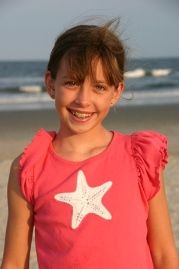Surviving childhood cancer: A mother's advice

Three years ago, my daughter, Julia, and I ordered yellow ribbons for Childhood Cancer Awareness Month in September and handed them out at Johns Hopkins Hospital in Baltimore. At the time, no one had heard of Childhood Cancer Awareness Month. Now, through the use of social media and the web, many more people have recognized September's significance, but it's still not enough. For us, Childhood Cancer Awareness Month is monumental. In 2006, when Julia was three-and-a-half years old, she would throw up every few weeks. After a couple of months, she began throwing up every few hours. As we were getting ready to go to the doctor, Julia had a seizure. We went straight to the emergency room and soon learned she had a tumor the size of a lemon in her occipital lobe. We went to the University of Maryland for surgery 36 hours later. After testing, she was diagnosed with grade 3 anaplastic supratentorial ependymoma. Ependymomas are very rare and only occur in about 500 people per year, yet they are the third most common childhood brain tumor. Surgeons were able to remove the entire tumor, giving Julia a better chance for long-term survival. Every day for six-and-a-half weeks Julia underwent radiation at Johns Hopkins Hospital, dressed up in her favorite dress-up clothes to lift her spirits. Since radiation treatment, Julia's MRIs have shown no recurrence.Julia has permanent hair loss on the back of her head and a loss of peripheral vision. Her cognitive development is a little slower, but within normal limits. Julia is now a six-year brain cancer survivor and celebrated her tenth birthday this past June! Although our journey with brain cancer will never be over – Julia will have scans the rest of her life –as more time passes, the more easily I can breathe.When Julia was diagnosed it was like a nuclear bomb landing upon our young family. I look back and wonder how we made it through. If I could offer any advice to newly diagnosed families it would be: 1. Confirm the pathology report and get second and third opinions from top cancer centers and children's oncology group hospitals.2. Advocate for your child! As a trained Child Life Specialist, I had the unique knowledge that I had a voice in how my child was cared for and treated. Hospitals and their procedures are not always family-centered. Speak up! Let them know what works best for your child because you know him or her the best.3. Find a support group. Online support groups were my guiding light in those early days and many even offered to talk with us over the phone. Now, social media and Facebook offer great support. Talking with other parents who have walked in your shoes is the most valuable advice I can give. It can be scary and many people may shy away because there are some tough moments in these groups – kids are very sick and some will pass away. Don't let this deter you from gaining wisdom from those who have been there.4. Find resources on the web. Be prepared for sad stories, but also stories with a lot of hope. There is a lot of inaccurate information out there, so follow trusted sources like St. Jude Children's Research Hospital for children with cancer and the CERN Foundation for ependymoma patients.5. Start a Caring Bridge page, an online blog or journal. Writing was very therapeutic for me and kept everyone informed. 6. There is so much hope. Grab it and don't let it go. As Julia was going in for port surgery, I was rocking her outside the operating room. An OR nurse came out and shared that her daughter had been diagnosed with cancer as a child and was now a teenager active in sports and school. She gave me the gift of hope, and I cried silent tears of gratitude. Julia remains cancer-free and I am paying her gift forward to all of you: Believe.Sue Mead is a contributor to the Collaborative Ependymoma Research Network (CERN) Foundation community. The CERN Foundation is comprised of a group of scientists and neuro-oncologists working to find new treatments for ependymoma, a rare type of brain tumor. You can read Sue's story and others affected by ependymoma at cern-foundation.org.
Cannabis Talks During Cancer, Cardiometabolic Comorbidities and Current Research
March 4th 2024In addition to a breakthrough therapy designation for a lung cancer drug, this week we’ll be talking a lot about additional side effects and health conditions that may come with a cancer diagnosis, and how to manage them.
Listen